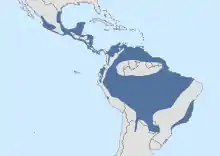Hook-billed kite
The hook-billed kite (Chondrohierax uncinatus), is a bird of prey in the family Accipitridae, which also includes many other diurnal raptors such as kites, eagles, and harriers. It occurs in the Americas, including the Rio Grande Valley of Texas in the United States, Mexico, the Caribbean, Central America, and tropical South America.
| Hook-billed kite | |
|---|---|
 | |
| Hook-billed kite in Pasco, Peru | |
.jpg.webp) | |
| Scientific classification | |
| Kingdom: | Animalia |
| Phylum: | Chordata |
| Class: | Aves |
| Order: | Accipitriformes |
| Family: | Accipitridae |
| Genus: | Chondrohierax |
| Species: | C. uncinatus |
| Binomial name | |
| Chondrohierax uncinatus (Temminck, 1822) | |
| Subspecies[2] | |
| |
 | |
It is a mid-sized, slender raptor with an invariably striped belly and banded tail but there is probably more individual variation in color and in size of bill than in any other species of diurnal raptor. Birds from beneath can look blackish or gray (especially males) and brown or brick-red (females) variously. This renders species identification at times extremely difficult. The downcurved hook at the tip of the beak is apparent on perched and low-flying birds. Weight can range from 215 to 397 g (7.6 to 14.0 oz) and length is 38–51 cm (15–20 in).[3][4]
Tree snails are a vital component of the hook-billed kite’s diet. The density of their population within a region is proportional to the presence of tree snails. It has also been observed that the beak of the hook-billed kite has adapted in size and shape between different regions of their territory in response to the species of tree snail available to them.[5] However, frogs, salamanders, small mammals and insects are also taken. When it finds a tree snail it holds it with its talon and uses its beak to pry open the shell. The nest, a flimsy platform of sticks, is built by both sexes. The hook-billed kite lays two to three buff-white eggs marked with red-brown. Incubation is by both sexes. Semialtricial young stay in the nest 35–45 days and are fed by both sexes. This raptor is often considered sluggish and retiring, preferring to perch inside leafy canopy when not flying.
The critically endangered Cuban kite, C. wilsonii, is considered by some authors to be a subspecies of the hook-billed kite.
References
- BirdLife International (2012). "Chondrohierax uncinatus". IUCN Red List of Threatened Species. 2012. Retrieved 26 November 2013.CS1 maint: ref=harv (link)
- Gill F, D Donsker & P Rasmussen (Eds). 2020. IOC World Bird List (v10.2). doi : 10.14344/IOC.ML.10.2.
- Marshall Cavendish Corporation (2001): Endangered Wildlife and Plants of the World on Google Books
- Dunne, Pete (2012). Hawks in flight : the flight identification of North American raptors (2nd ed.). Boston: Houghton Mifflin Harcourt. p. 301. ISBN 978-0-395-70959-7.
External links
| Wikimedia Commons has media related to Chondrohierax uncinatus. |
| Wikispecies has information related to Chondrohierax uncinatus. |
- Stamps for Cuba, Honduras; (includes RangeMap)
- Associação Mãe-da-lua Hook-billed Kite
